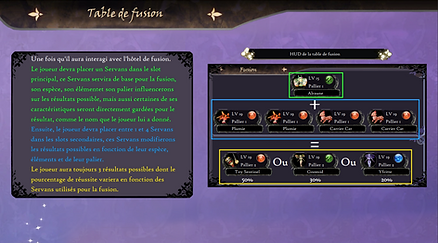TAMARELLE-WEBER ALEXANDRE
Game designer / Level designer / Tech Designer
Night of Azure Blacksmith
(not affiliated with Koei Techmo or Gust)
.png)
-
Role: Game designer
-
Team size : 2
-
State: Finished
-
Duration: December 2023
-
Genre: Action RPG
Only French version available
Intro
This is a work I did as part of my first year of a master's degree in game design. The rule was to create a document describing two crafting systems for the same game. After some thought, my classmate and I decided to use an existing game instead of creating an original game for this assignment. We chose to try and create crafting systems with the idea of a spin-off from the game Night of Azure, the aim being to remedy the game's lack of a progression system.
Create crafting systems
Our aim was to create two crafting systems based on mechanics that already existed in the original Night of Azure, to create an engaging and satisfying progression throughout the game. As the first game already had a creature system that helped the player in combat, we decided to create a fusion system so that the player could create creatures themselves and the second was a system where the player could obtain new transformations during the course of the game.
Fusion Monsters
For this first crafting system, we were mainly inspired by the fusion system from Atlus' Shin Megami Tensei saga, but we wanted to have a bit of randomness to encourage the player to try the system more often and test more creatures, we also simplified certain mechanics to avoid discouraging the player through lack of understanding, and added a tier system that lists the power of the monsters and what you can obtain.
Establishing the basis of the system was the easiest part, it was the details that were hard, defining yourself which monster you get, whether you merge a weak monster with a powerful one, whether you merge a lot of monsters with different monsters, and so on, which is also why we decided to simplify the system. And at the end of the day, we were equally satisfied with the fact that the system retained a minimum of complexity.
.png)
We wanted that the player can use multiple combination and also that the result have a part of aleatory.
.png)
For balancing the fusion system we choose to create a system tier based that define the power of monster.
Transformation Tree
For the second crafting system, because the character in the original game had the ability to transform in combat but in the game there were only five transformations, we decided to design a system where there are more transformations and the player has to unlock them like a skill tree.
To unlock a transformation, the player must have the necessary ingredients and the previous transformations in the tree.
This system makes unlocking transformations more engaging than in the original game, where transformations was obtained by progressing through the story and the composition of the team.
.png)
The progression tree.
.png)
How to obtain materials for the transformation tree.
What have I learned?
It was the first time I'd designed such an advanced progression system, and I really enjoyed it. The choice of taking an existing game and trying to come up with a new system for a spin-off was also really enjoyable.
But now I'm sad that the game will never be released.